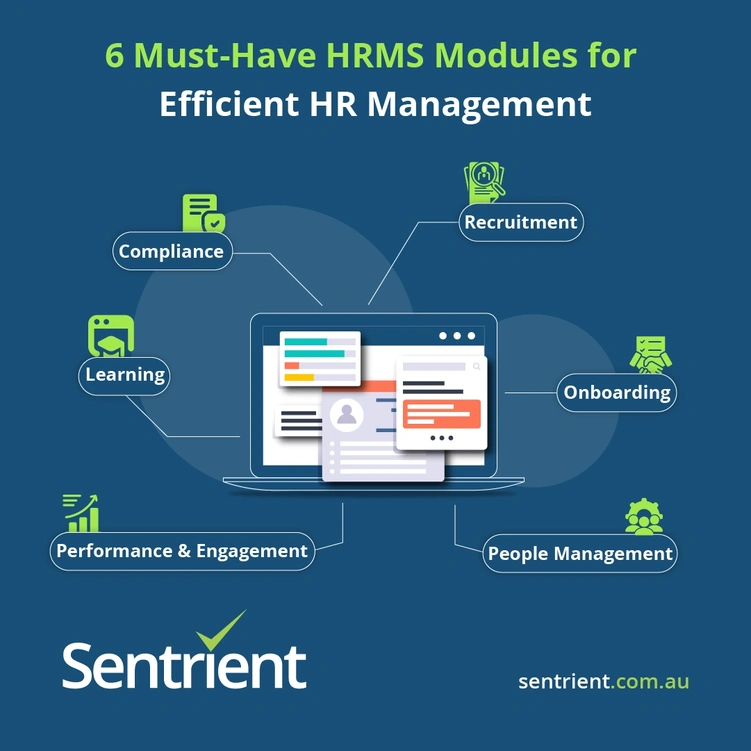Human resource management systems (HRMS) work toward reducing manual tasks and providing automation with HR tasks. They also help reduce the efforts and time required by HR personnel to perform routine human resource management processes. The best HRMS software incorporates all primary functions of the human resource management lifecycle and delivers them with an easy-to-use interface.
The primary functions of an HRMS include employee recruitment, learning and development, right through to employee management. Let’s discuss the crucial modules that every successful HRMS must include.
6 Must-Have HRMS Modules

1. Recruitment
The process of recruiting employees begins with generating a job requirement. It is followed by tasks such as accepting applications, screening candidate details, conducting interviews, shortlisting candidates, performing reference checks, providing job offers, and recording the candidate’s acceptance. All these tasks take up HR personnel’s time and are difficult to carry out successfully if using paper-based documents or simple spreadsheets.
The recruitment module in a well-built HRMS automates this whole process, and HR personnel input is reduced. Authorised employees can access candidate information through a workflow system to enable easy screening and reference checks. The system can also set reminders for interview schedules. Once the job offer has been accepted, the candidate profile is converted into a staff member record and rolled over to the onboarding module.
2. Onboarding
Once you have finalised the recruitment process, there is a new employee member who needs to be briefed about your organisation. Employee onboarding includes induction programmes to let the new hire know more about your business goals, mission, vision, and the standards of work and professional behaviour expected from them. This is the stage where new hires are introduced to business policies and procedures.
An HRMS system helps HR professionals maintain a standard onboarding process for all new hires. It enables easy management of new employee information such as bank details, superannuation, etc. It also allows the new employees to enter their own details in the system, which saves HR personnel time to focus on other important tasks.
3. Learning
Employees should be trained to upgrade their skill sets regularly. Organisations can invest in helping their employees learn and acquire new skills through an internal learning and development module. This module must be incorporated by advanced HRMS software.
A learning module enables managers and HR personnel to manage formal and informal learning and assessment programmes. It also contains provisions to publish learning content online or manage and schedule learning events and webinars as required. Including this module can instil a sense of growth for the employees. They are likely to perform better and stay longer if they feel they are growing with their organisation.
4. Performance and engagement
Employee performance and engagement evaluation mechanisms can be the foundation stone for driving employees towards better performance. An HRMS must include this module to help HR personnel and organisational managers run and record performance reviews, gather staff and manager ratings, enquire about individual performance plans, etc. All these activities are an important part of a performance management system.
HRMS must also help organisations run surveys and gather formal feedback from employees related to their performance. 360-degree surveys play a crucial role in making a performance evaluation system successful.
5. Compliance
Compliance to laws and regulations is a mandatory requirement in every department of an organisation. To guide your employees about the regulations that apply to their work and workplaces, HRMS must include a compliance module. For example, the Sentrient HR management system includes all the features of the Sentrient workplace compliance system. It consists of policies such as health and safety, cybersecurity, etc. This compliance module also has courses to guide employees about compliance, record management, safety culture surveys, etc.
6. People management
A people management or employee management module can help HR personnel manage all employee attendance-related records and also serve as a mode of communication. It allows HR personnel to manage leave records, publish organisation-wide announcements, upload and share images of past events, reward employees for their efforts, run a calendar, etc.
This module in an HRMS also serves as the mode of semi-informal feedback from employees about must-do activities. They can participate in online surveys being held for their specific department, team, or the entire organisation. Employee feedback is a powerful tool for business growth when handled correctly. Organisations must put more emphasis on this module to keep their employees engaged.
A word from Sentrient HR:
Sentient’s HRMS combines all these modules to create powerful software that helps HR personnel and employees throughout your organisation. It can be customised as per your business size and requirements. Sentrient’s HRMS can be the catalyst of growth for your organisation. Contact us today and book a free demo!
Read More About HR Management System:
- What is a Human Resource Information System (HRIS)?
- Best Practices for Effective Offboarding According to HR Experts
- Benefits Of Having HR Management Software In Your Organisation
- Human Resources Software: Definition And How To Choose The Best HR Software?
- The Top 5 HR Practices That Impact HRMS Success





